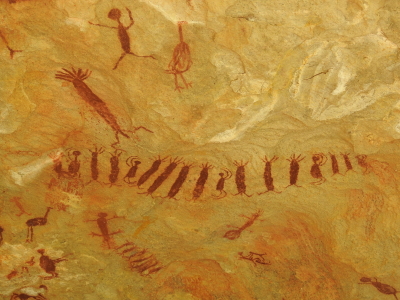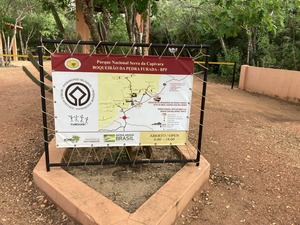Serra da Capivara

Serra da Capivara National Park holds many rock shelters in which the oldest rock art of the Americas has been found.
The art and associated archeological sites reveal aspects of the religious beliefs and practices of one of the oldest populations to inhabit South America. The earliest traces of rock painting here may date from 25,000 BP, while most of the painted works are from 10,000 to 4,000 BCE. They were made by Nordeste and Agreste cultures.
Community Perspective: all reviewers so far loved it, and you can easily spend 2-3 days here. The Caatinga landscape of the park, typical of this semi-arid region, is an additional bonus. Be aware that you need a local guide to enter: some contacts can be found in the reviews of Wojciech and Els, or you could ask at your lodgings the night before your visit.


Map of Serra da Capivara
Community Reviews
Els Slots

Although Wojciech and Michael already captured the essence of this site excellently after visits as recent as 2019 and 2020, I have a few observations to add after my 1.5-day stay in December 2022. They consider (1) the logistics, (2) the core zone, and (3) the criteria the site was inscribed on.
Logistics. Azul now has direct flights from Recife three times a week to Sao Raimundo Nonato, some 30 km from the main park entrance. Whether this connection is viable is questionable, as the park is mostly visited by school groups arriving by bus. Park admission is free, but you have to hire a local accredited guide beforehand (still 200 B$ a day, when you bring the car) and sign up at the gate. I teamed up with Antoniel (+55 89 8108-8706), by whatsapping him the night before my visit. I came to think of him as my personal trainer, as he walked quite fast and liked to climb (we hiked 8 and 6 km respectively per day). I think he would be happy to take you on one of the more strenuous hikes in the park! But he knows his rock art and birds well also. He only speaks Portuguese.
Core zone. Both the old and new official maps are unhelpful. Important to remember is that the park is huge and has four entrances + some isolated locations around it. The amount of sites and trails is overwhelming (there’s a great book available that describes them all), I let the guide choose and he did well I think. The main entrance is at Pedra Furada, where the two main rock art panels are found (Pedra Furada and Meio), both with archaeological excavations at the base of the rock shelter as well. But we also visited Invencao (behind a village), and on the second day, we entered the park via the Desfiladeiro trail. That gives you access to the sites of Pajaú, Paraguaio, Baixao da Vaca and Barro, and for me, that lifted the overall visit rating from a 3.5 star to a 4. The first three are the rock art sites that were among the earliest discoveries by Niède Guidon. Their condition is brilliant, and also very good for photos due to the light background they were painted on. The latter is in a former riverbed, and has rock art on pebbles!
The museums related to the site - one about its cultural history (Museu do Homem Americano), and the other about its nature – are probably in the core zone as well. Both are very modern, maybe geared a bit too much towards the school children which seem to be the main target group of visitors, but still commendable as they were designed to keep the findings from within the park close to their origins. If pressed for time, I’d skip the museums for more time on the ground in the park itself.
Criteria. In my opinion, this site was inscribed too early in its history of rediscovery to be valued fully: it happened in 1991, while most excavations and findings date from the 1970s at the earliest. The early dating of these findings was still controversial. Consequentially, the site was inscribed on one criterion only with a heavy focus on rock art.
Now it is considered a key site in the scientific study of the settlement of humans in the Americas. Much of what we know has been established as recently as 2004, and the debate is still going on with much controversy. Together with sites in Chile (Monte Verde) and Colombia (Chiribiquete), it seems to prove that waves of 'immigrants' populated mainly South America much earlier than previously thought (30,000 BP versus 13,000 BP, the so-called Pre-Clovis theory). Serra da Capivara has been excavated by Brazilian and French teams, and they seem to position themselves more or less deliberately opposite of archaeological theories from the USA. In the Museu do Homem Americano they advocate the even more farfetched idea that the oldest ‘immigrants’ came directly from Africa to South America, so not via the Bering Strait.
And then there’s the issue of disregarding the natural values – so little had been written about it in the original nomination that IUCN couldn’t make a recommendation (though it admitted that the park holds 40% of all rare caatinga vegetation). At a second try, in 2003, it was downright rejected. It still hopefully lingers on the Brazilian Tentative List, possibly as part of a serial nomination of caatinga sites.
PHOTOS (top to bottom left: fishing, river animal, pebble art; top to bottom right: extracting honey (holding a hand in front of your eyes), dancing around a tree, "the first American kiss")
Read more from Els Slots here.
Wojciech Fedoruk

Serra da Capivara is the least visited WHS in Brazil. The reason is the relative inaccessibility of this place - from southern Piaui, where the park is located, everywhere is far away, and the nearest WHS is Sao Francisco Square, about 900 km away. It's best to get to Petrolina by plane (by the way, the name of this place has nothing to do with crude oil), which is about 5 hours away from the park by car (I covered this route in 4 hours in the early morning - but be warned, there are plenty of holes in it).
Me and my family got to the park in November 2020 from Chapada dos Veadeiros, and the 1300-kilometer route took us about 15 hours net with a stop for the night in Barreiras. The road, apart from the last leg in Piaui, is quite nice and very picturesque, especially the first part from Chapada dos Veadeiros do Barreiras. It was absolutely worth the effort - Serra da Capivara is definitely my number one place among the rock art WHS.
In preparation for the trip, I looked at the list of obligatory guides available on the icmbio.gov.br website (currently, however, the site has been unavailable for a long time) and contacted one who was supposed to speak English. It turned out, however, that the declaration of the guide was not true. According to the locals, the only guide who speaks good English is Waltercio Torres Correia - tel./whatsapp + 55898131-5923, who, however, takes up to 400 reais from foreign tourists for his services. Waltercio was unavailable, but the locals found us another guide - Rafael Moraes (tel. + 558998129-0151), who spoke basic English but was professional and sympathetic and took the standard rate of 200 reais.
The park itself is very extensive and picturesque, but as it was inscribed solely on the cultural criteria, we were mainly interested in places with rock art. Most are concentrated close to the main gate, near Pedra Furada - a picturesque rock with a hole in the middle, which is a symbol of the park. The art is wonderful - made with different techniques and different colors of paints, it presents not only ‘standard’ animals and hunting scenes, but also scenes of gymnastic exercises and dancing. There are surprisingly many references to sex and reproduction - one of the symbols of the park is the drawing of a kissing couple, but there are also drawings of men with erect penises (see photo) and the sexual acts themselves. The most spectacular drawings are a few kilometers away from Pedra Furada, but the whole standard route can be visited within 2-4 hours.
All this can be admired in the surroundings of wonderful nature - monumental rocks, lizards, large rodents (the name of the park comes from the capybara, the largest rodent in the world) and birds.
The entrance to the park is just near to Coronel Jose Dias, a small town that has a decent accommodation base. We slept in Casa Barreirinho, owned by a German who has lived in Brazil for several years. Right next to it, there is another, larger Albergue e Pousada Serra da Capivara, which has many more rooms, a restaurant and a huge factory of pottery decorated with motifs taken from rock drawings. You can also buy T-shirts and other souvenirs there. It turns out that Serra da Capivara in 'normal' times is a very popular place among local tourists and Coronel Jose Dias is often visited by school trips from such distant cities as Fortaleza, Recife or even Salvador.
A visit to the park should be enriched with a visit to two museums - Museu da Natureza in Coronel Jose Dias and Museu do Homem Americano in Sao Raimundo Nonato. At the time of our visit, unfortunately, both museums were closed due to the pandemic. Nevertheless, we enjoyed the visit very much, especially since in Coronel Jose Dias we met by chance a local priest from Poland who took us to the Polish bishop of the diocese of Sao Raimundo Nonato, Edward Zielski.
Michael Ayers

Visit in November 2019
Sites that have been inscribed primarily to protect important areas containing ancient Rock Art are among my favorite types of sites to visit and it had been a fairly long time since I had been to a site from that category. Consequently, I was definitely looking forward to my visit to Serra da Capivara National Park. Though I only had one full day available for this visit, I found the park to be beautiful and fascinating, and felt that my time there was well spent.
As the previous review mentioned, the park is a long way from anywhere else that most travelers might be when visiting Brazil, so getting to the area will generally be time consuming. The transport infrastructure is in reasonably good condition coming from any direction, but, while the small cities and towns that one will pass through along the way are friendly, and contain most of the important services, they are usually not the most attractive examples to be found in Brazil. One of the nicer places is São Raimundo Nonato, the main service center for the park, located just to its south. I used that town as my base for this visit, but there is also a small hotel with a restaurant in the park, adjacent to the main entrance, just to the west of the village of Coronel José Dias. If my timing had been a little different, or if I was able to spend more than one day at the park, that option would have probably been preferable.
I believe in the past one could visit the park independently, but now it is obligatory to use a local guide. I arrived at my hotel, eponymous with the park, late in the day, and I was a little worried that I would have trouble making arrangements for a visit the next day on short notice. Fortunately, the hotel receptionist was able to make the call for me and it only took a few minutes to get that taken care of. The cost for a full day visit was just over ninety US Dollars, but if I had been able to provide my own transportation for myself and the guide, it would have been around half of that. Like many tourist sites in Brazil, most guides there only speak Portuguese and so, for some visitors, that could be an issue. However, I usually don’t mind going on a tour with minimal conversations, and for most of the really important information mobile device translators do a satisfactory job.
One instance where I was concerned about communication was with the itinerary of the tour. There are a very large number of important Rock Art sites scattered throughout the park, and I wanted to be sure that I saw a good selection of those, without having to spend an inordinate amount of time just getting to the sites. However, without being able to discuss that effectively, I took a chance that the standard itinerary would be to my liking. Fortunately, it was, and I was pleased with what I was shown. The park is an area of smallish, partially rounded hills composed of sedimentary rocks with a wide variety of aggregate sizes, containing many shaded areas and somewhat moderate amounts of water, in contrast to the more level surrounding terrain. With that in mind, it is obvious why people have made that a place of importance for many millennia.
I was shown a few slot canyons, which I was not expecting, but thoroughly enjoyed, two small pictograph galleries, and two of the major galleries. The pictographs were all easily seen from wooden walkways that were the perfect distance from the art, not close enough to encourage touching the drawings, but still being able to see everything perfectly clearly. Depictions of animals and human activities dominated the galleries that I saw, with relatively few abstract designs that are sometimes common at other sites. Two fairly unique aspects of the galleries were images of what are believed to be South American megafauna species that went extinct at the end of the Pleistocene Age, and smooth, fist-sized river stones in the aggregated cliff walls that were used as "canvases" for paintings of tiny animals. Compared to other Rock Art sites I have seen, WHS or otherwise, I would rate this site near the top, almost to the level of Kakadu of Cueva de los Manos.
There are two relatively new museums associated with the park, one in São Raimundo, the Museum of American Mankind, and one near the main entrance to the park, the Museum of Nature. I would have been more interested to see the first in this case, but unfortunately I didn’t have enough time for that. The Nature museum was an optional stop on my tour, so I did visit that one. At first, the exhibits do not seem to be very relevant to the Park’s ouv, focusing on general aspects of nature and geological history. Further along, there are some nice fossils of the former megafauna, and then a Virtual Reality simulation of taking a hang-glider flight over the park, which does provide an interesting additional perspective on why that place had been so useful to people throughout time. That left me with the impression that Serra da Capivara really should have been inscribed as a mixed site. While the semi-arid Caatinga habitat of this region of Brazil does have similar counterparts elsewhere, it is distinctive in its own way there, and within the park boundaries its health appeared, to me, to be relatively good, compared to the surrounding areas, which have already been greatly affected by human activities.
Read more from Michael Ayers here.
João Aender
I visited Serra da Capivara NP some months ago. Truly an amazing experience. It takes time and planning to get there, as the closest airport is 400 km away, but newly paved roads make it accessible.
It usually takes three days and lots of hiking with an accredited guide to spot the most famous rock paintings the park is famous for. Most of them are 6.000 to 12.000 years old, but some are said to be much older - some researchers belive that's the proof that the first Americans also came from Africa, crossing the Atlantic Ocean during Ice Age, and not only from Asia through Alaska.
The painting are plentiful and depict various themes such as hunting and adoration, but also regarding sex intercourse, animal habits, honey collecting, etc.. Very interesting indeed.
There is very little left in Brazil about human activity before the Portuguese colonizers. Serra da Capivara is a remarkable exception.
Peter Ravenscroft
I have, I much regret, not got there yet, just via hyperspace. But I would like to observe that this is perhaps the most important early human site found in the Americas to date. Given the recently obtained dates, of around 50,000 BP, it is the oldest known. The similarities of the rock art, to Australian aboriginal rock art, given the other archaeological and cultural similarities between these two distant regions, and to finds in the Middle East, will re-write the entire story of early human expansion.
Caron De Mars
US citizen living in Brazil - 01-May-05 -
FANTASTIC!!!! I'm a diplomat who has lived in Brazil for almost two years. I've travelled around quite a bit. As far as stark beauty, good hiking, and incredible history, this place can't be beat. The guides are professional and knowledgabe. I vowed I'd only go to sites once since Brazil is such a rich, vast country full of treasures, and I know I'd only live here two years. Well...I broke my vow, and I'm going back this weekend.
Community Rating
Site Info
Site History
2003 Rejected
Regarding extension on natural criteria
1991 Inscribed
Site Links
Unesco Website
Official Website
Related
In the News
Connections
The site has 22 connections
Damaged
Ecology
History
Human Activity
Individual People
Science and Technology
Timeline
Trivia
Visiting conditions
WHS Names
WHS on Other Lists
World Heritage Process
Visitors
15 Community Members have visited.
